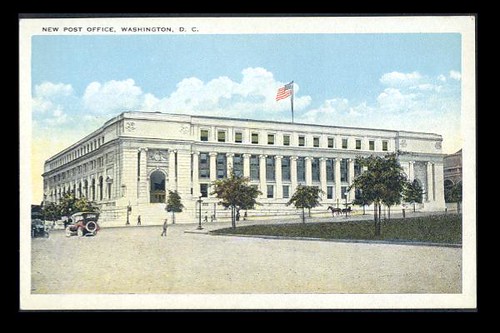Historic preservation aspects of US Post Office downsizing
“The Postal Service is the most visible and ubiquitous federal institution in America. … The daily visits that citizens make to local post offices have shaped the development pattern of many towns. Business districts have grown up around post offices, allowing postal customers to shop, dine, and take care of other needs in one convenient area."
– from "Public Buildings Should Set the Standard," by Edward McMahon, in the Winter 2001 issue of the Planning Commissioners Journal.
--------------------
USA Today has an article, "Parceling out old post offices," about how the US Postal Service is selling off facilities to raise cash, in the face of their financial problems. From the article:
Municipalities have purchased some post offices in an attempt to keep them open. In Boone, N.C., the town's planning department will set up shop in the downtown post office after the Town Council agreed to buy the 73-year-old building for $1million, said Bill Bailey, Boone's planning director. In turn, the town leased a portion of the building back to the Postal Service to keep the post office running.
Of the 31,300 Postal Service branches across the nation, about 8,900 are owned by the government, and the rest are leased.
The website Save the Post Office is a resource for groups working to preserve post office buildings in their home communities.
I have written in the past about the Post Office building's role in presenting the face of the federal government in local communities, and how this needs to be taken into account when planning service and changes to facilities and functions. See "Rethinking community planning around maintaining neighborhood civic assets and anchors."
And this piece suggests that one way for the USPS to maintain relevance for post office facilities in the face of a reduction of the use of mail services would be to refocus the spaces as places to support local entrepreneurship as co-working spaces. See "Post offices reconceptualized as small business support centers"
That being said, I do understand the desire on the USPS to rightsize facilities and functions, not just to generate cash to use for pension obligations, but to reduce their costs. The pieces above suggested co-location of post office facilities with local government facilities as a way to provide service at lower cost.
But that doesn't get at the desire to save (historic preservation) the remarkable buildings that many Post Office buildings are, either or both inside (some facilities have great murals and other public art) and outside.
This has actually been an issue going on for decades in terms of another dimension, the closure of post office facilities in Downtowns and traditional shopping districts in favor of facilities designed to support automobility.
 In Washington, DC, three large old post office buildings have been adaptively reused, although 1 of the 3 attempts thus far has been unsuccessful. The early 1800s main post office building is now Hotel Monaco. The building had been empty for many years previous to that use.
In Washington, DC, three large old post office buildings have been adaptively reused, although 1 of the 3 attempts thus far has been unsuccessful. The early 1800s main post office building is now Hotel Monaco. The building had been empty for many years previous to that use.The next now Old Post Office building on Pennsylvania Avenue has been used as a retail and office facility but not successfully. It's slated to become a hotel.
In the 1980s, the Main Post Office building (postcard image above) next to Union Station (which has been supplanted by the construction of a new main post office a few miles north, constructed in an industrial area) became a mixed use facility, with a much smaller post office, and with a restaurant, offices (for the Bureau of Labor Statistics), and a new postal museum sponsored by the USPS in association with the Smithsonian Institution.
And since then, the USPS has sold off some sites for redevelopment, such as in Arlington County, Virginia ("Major Office Development Coming to Clarendon" from Arlington Now) and Silver Spring Maryland ("Residential units to replace Silver Spring post office" from the Gazette).
In fact, the Post Office in DC's Georgetown neighborhood, which once served as a customs house as well, when Georgetown functioned as an international port (which is why the building is particularly imposing), has been sold recently as well ("Georgetown post office set to be sold" from the Washington Business Journal").
Image from the Georgetowner article, "Postal Service Sells Georgetown Post Office to EastBanc."
Labels: civic assets, entrepreneurialism, historic preservation, land use planning, post offices, provision of public services, urban design/placemaking




2 Comments:
"...Old Post Office building on Pennsylvania Avenue has been used as a retail and office facility but not successfully..."
I wonder how you define success in this case. Although the retail aspect of the Old Post Office is no longer functional, it had a pretty long run - from 1983 until 2003 or so. It's offerings may have been limited - a food court - but it served a real need, tourists and nearby office workers, and it's not clear that the lack of upkeep wasn't a factor in its fade. Meanwhile, the office aspect is ongoing, although will be displaced by the hotel redevelopment. So in neither case was the use endless, but many retail or office complexes find themselves in need of major updating after 30 years' service. In this case however, the owner (the fed govt) chose to radically change the use rather than upgrade the existing uses. That choice doesn't necessrily mean the adaptive reuse was unsuccessful.
I have enjoyed reading your articles. It is well written. It looks like you spend a large amount of time and effort in writing the blog. I am appreciating your effort. You can visit my website.
coworking space mountain view
Post a Comment
<< Home